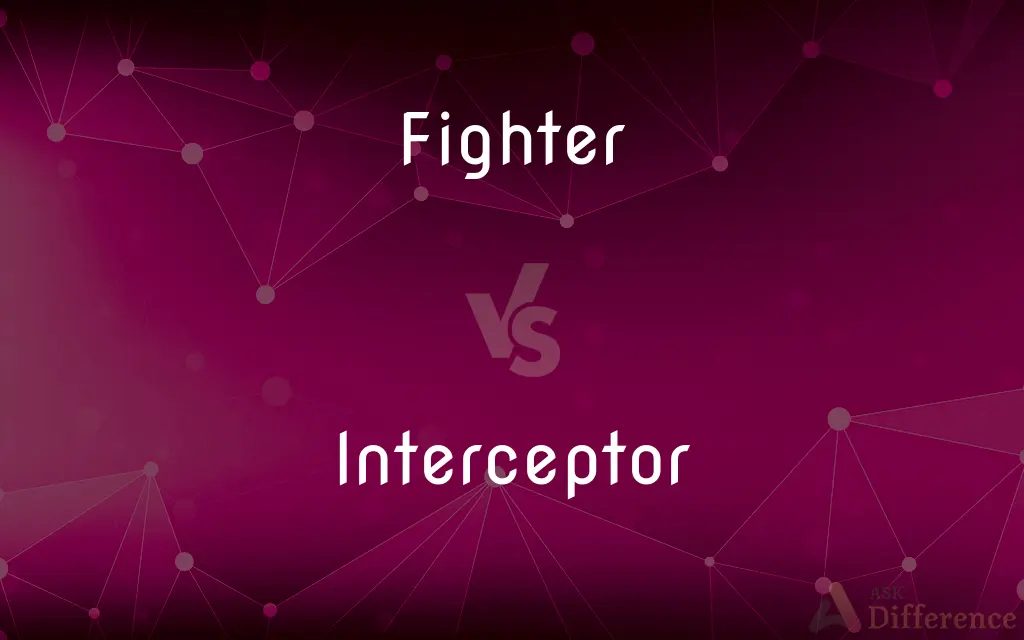Fighter vs. Interceptor — What's the Difference?
By Urooj Arif & Fiza Rafique — Updated on May 2, 2024
Fighter aircraft engage in a variety of combat roles, focusing on both air-to-air and air-to-ground attacks, while interceptors specialize in neutralizing aerial threats rapidly.

Difference Between Fighter and Interceptor
Table of Contents
ADVERTISEMENT
Key Differences
Fighter aircraft are designed for versatility in combat, capable of engaging targets in the air and on the ground. Whereas interceptors are specifically optimized for speed and altitude, aiming to intercept and destroy incoming enemy aircraft before they reach their targets.
Fighters often have robust armament options including cannons, missiles, and bombs to handle multiple combat scenarios. On the other hand, interceptors are usually equipped with advanced radar and air-to-air missiles, prioritizing speed and agility over versatility.
Fighters are integral to maintaining air superiority and can carry out extended missions over enemy territory. While interceptors excel in quick response and are primarily used for defensive purposes against aerial attacks.
Fighters can operate from varied platforms, including aircraft carriers and rough airstrips, providing flexible deployment options. In contrast, interceptors often require well-prepared bases due to their high-speed takeoff and landing characteristics.
Fighters typically have longer range and endurance, making them suitable for prolonged combat engagements. Interceptors, however, are built for sprinting rather than endurance, with a focus on short, decisive engagements.
ADVERTISEMENT
Comparison Chart
Role
Air-to-air and air-to-ground combat
Air-to-air combat, quick interception
Armament
Versatile: missiles, cannons, bombs
Specialized: mainly air-to-air missiles
Mission Type
Versatile: superiority, strike, etc.
Defensive: target interception
Operational Range
Long range and endurance
Short range, high speed
Deployment
Flexible: carriers, rough airstrips
Requires well-prepared bases
Compare with Definitions
Fighter
Often equipped with advanced avionics and electronic warfare capabilities.
Modern fighters feature integrated radar and sensor suites for enhanced situational awareness.
Interceptor
Used for defensive purposes to protect airspace.
Interceptors patrol the national borders to deter intruders.
Fighter
A military aircraft designed for air-to-air and air-to-ground combat.
The F-35 fighter is capable of stealth operations against ground and aerial targets.
Interceptor
Specializes in high-altitude, high-speed flight.
The interceptor reached supersonic speeds during the exercise.
Fighter
Can carry a variety of weapons systems.
The fighter was loaded with missiles and laser-guided bombs.
Interceptor
Primarily armed with air-to-air missiles.
The interceptor's missiles are designed for maximum effectiveness against enemy planes.
Fighter
Used to establish air superiority in a combat zone.
Fighters scrambled to establish control above the conflict area.
Interceptor
Requires specialized bases due to specific takeoff and landing needs.
The interceptor fleet is based at strategically located airfields.
Fighter
Operates from diverse platforms including aircraft carriers.
The naval fighter launched from the carrier to patrol the sea.
Interceptor
A fast-response aircraft primarily aimed at intercepting and destroying enemy aircraft.
The interceptor was dispatched to counter the incoming aerial threat.
Fighter
One who fights, such as a soldier or boxer.
Interceptor
One that intercepts, specifically a fast-climbing, highly maneuverable fighter plane designed to intercept enemy aircraft or a guided missile designed to intercept enemy missiles and spacecraft.
Fighter
A fast, maneuverable combat aircraft used to engage enemy aircraft.
Interceptor
Anything that intercepts something else.
Fighter
A pugnacious, unyielding, or determined person.
Interceptor
A fast, maneuverable fighter aircraft designed to intercept and destroy enemy aircraft before they can attack.
Fighter
A person who fights; a combatant.
Interceptor
A guided missile designed to intercept and destroy enemy missiles.
Fighter
A warrior; a fighting soldier.
Interceptor
A device to trap, remove, or separate hazardous or undesirable matter (such as oil or sand) from normal waste conveyed through it, permitting normal sewage or liquid wastes to discharge into the disposal terminal by gravity.
Fighter
A pugnacious, competitive person.
Interceptor
A hook routine that intercepts normal program flow to carry out a task.
Fighter
(eulogistic) A person with a strong determination to resist protracted or severe adversity, especially illness.
Interceptor
A sewer that intercepts sewerage destined for an outfall (e.g. into a river) and redirects it to a treatment plant.
Fighter
A class of fixed-wing aircraft whose primary purpose is to shoot down other aircraft, sometimes accompanied by a secondary purpose of attacking ground targets.
Interceptor
Same as intercepter.
Fighter
A participant in boxing or any martial art.
Interceptor
A fast maneuverable fighter plane designed to intercept enemy aircraft
Fighter
(colloquial) A firefighter.
Fighter
(video games) A game with a focus on physical combat.
Fighter
One who fights; a combatant; a warrior.
Fighter
A boxer; a pugilist.
Fighter
A person with the determination and will to persist through great difficulty to achieve a goal; one with the courage to fight and resist an opponent, and to struggle with all one's powers.
Fighter
A military aircraft designed to seek out and destroy enemy aircraft; it is usually smaller and more maneuvarable than aircraft designed specifically for bombing. However, hybrid fighter-bomber aircraft that perform both functions also are used.
Fighter
Someone who fights (or is fighting)
Fighter
A high-speed military or naval airplane designed to destroy enemy aircraft in the air
Fighter
Someone who fights for a cause
Common Curiosities
Can fighters perform the role of interceptors?
Yes, many modern fighters can perform interception roles but may not match the specialized speed and altitude capabilities of true interceptors.
How do the operational ranges of fighters and interceptors compare?
Fighters generally have longer operational ranges and endurance, whereas interceptors are designed for short, quick engagements.
What is the primary role of a fighter aircraft?
To engage in varied combat roles including air superiority and ground attack missions.
What are the strategic uses of interceptors in modern air forces?
Modern air forces use interceptors for the strategic role of airspace defense, particularly targeting high-speed, high-altitude threats to prevent air attacks.
How are interceptors different from general fighter aircraft?
Interceptors are specialized for rapid response and high-altitude, high-speed interception of enemy aircraft.
What are typical armaments of an interceptor?
Interceptors are typically equipped with air-to-air missiles and advanced radar systems for targeting.
What training is required for pilots of interceptors compared to fighters?
Pilots of interceptors typically undergo specialized training focused on quick response and high-altitude tactics, whereas fighter pilots receive comprehensive training that includes air-to-air, air-to-ground, and multi-role operations.
Are there any fighters that have been specifically designed with interceptor capabilities?
Yes, some fighters like the F-15 Eagle have been designed with enhanced interceptor capabilities, providing both air superiority and high-speed interception functions.
How does the maintenance of interceptors differ from fighters?
Maintenance of interceptors often involves specialized upkeep due to their high-performance engines and flight systems, which differ from the more general maintenance programs for multi-role fighters.
What is the significance of speed in an interceptor's design?
Speed is crucial in an interceptor's design to allow it to rapidly engage incoming threats before they can reach critical areas.
How has the role of interceptors changed with advancements in drone technology?
With advancements in drone technology, interceptors are increasingly tasked with engaging high-speed unmanned aerial vehicles in addition to manned aircraft.
What future developments are expected in the design of fighters and interceptors?
Future developments may include enhanced stealth capabilities, improved engine efficiency, and integration of artificial intelligence for better performance in combat scenarios for both fighters and interceptors.
Share Your Discovery

Previous Comparison
Lean vs. Prop
Next Comparison
Troposphere vs. ThermosphereAuthor Spotlight
Written by
Urooj ArifUrooj is a skilled content writer at Ask Difference, known for her exceptional ability to simplify complex topics into engaging and informative content. With a passion for research and a flair for clear, concise writing, she consistently delivers articles that resonate with our diverse audience.
Co-written by
Fiza RafiqueFiza Rafique is a skilled content writer at AskDifference.com, where she meticulously refines and enhances written pieces. Drawing from her vast editorial expertise, Fiza ensures clarity, accuracy, and precision in every article. Passionate about language, she continually seeks to elevate the quality of content for readers worldwide.
















































